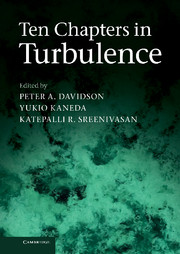Book contents
- Frontmatter
- Contents
- Preface
- Contributors
- 1 Small-Scale Statistics and Structure of Turbulence – in the Light of High Resolution Direct Numerical Simulation
- 2 Structure and Dynamics of Vorticity in Turbulence
- 3 Passive Scalar Transport in Turbulence: A Computational Perspective
- 4 A Lagrangian View of Turbulent Dispersion and Mixing
- 5 The Eddies and Scales of Wall Turbulence
- 6 Dynamics of Wall-Bounded Turbulence
- 7 Recent Progress in Stratified Turbulence
- 8 Rapidly-Rotating Turbulence: An Experimental Perspective
- 9 MHD Dynamos and Turbulence
- 10 How Similar is Quantum Turbulence to Classical Turbulence?
Preface
Published online by Cambridge University Press: 05 February 2013
- Frontmatter
- Contents
- Preface
- Contributors
- 1 Small-Scale Statistics and Structure of Turbulence – in the Light of High Resolution Direct Numerical Simulation
- 2 Structure and Dynamics of Vorticity in Turbulence
- 3 Passive Scalar Transport in Turbulence: A Computational Perspective
- 4 A Lagrangian View of Turbulent Dispersion and Mixing
- 5 The Eddies and Scales of Wall Turbulence
- 6 Dynamics of Wall-Bounded Turbulence
- 7 Recent Progress in Stratified Turbulence
- 8 Rapidly-Rotating Turbulence: An Experimental Perspective
- 9 MHD Dynamos and Turbulence
- 10 How Similar is Quantum Turbulence to Classical Turbulence?
Summary
Vorticity fields that are not overly damped develop extremely complex spatial structures exhibiting a wide range of scales. These structures wax and wane in coherence; some are intense and most of them weak; and they interact nonlinearly. Their evolution is strongly influenced by the presence of boundaries, shear, rotation, stratification and magnetic fields. We label the multitude of phenomena associated with these fields as turbulence and the challenge of predicting the statistical behaviour of such flows has engaged some of the finest minds in twentieth century science.
The progress has been famously slow. This slowness is in part because of the bewildering variety of turbulent flows, from the ideal laboratory creations on a small scale to heterogeneous flows on the dazzling scale of cosmos. Philip Saffman (Structure and Mechanisms of Turbulence II, Lecture Notes in Physics 76, Springer, 1978, p. 273) commented: “… we should not altogether neglect the possibility that there is no such thing as ‘turbulence’. That is to say, it is not meaningful to talk about the properties of a turbulent flow independently of the physical situation in which it arises. In searching for a theory of turbulence, perhaps we are looking for a chimera … Perhaps there is no ‘real turbulence problem’, but a large number of turbulent flows and our problem is the self-imposed and possibly impossible task of fitting many phenomena into the Procrustean bed of a universal turbulence theory.”
- Type
- Chapter
- Information
- Ten Chapters in Turbulence , pp. ix - xPublisher: Cambridge University PressPrint publication year: 2012



